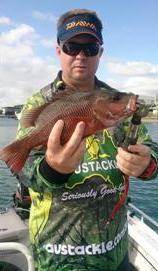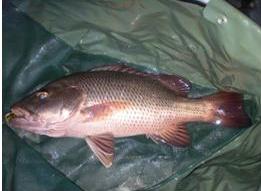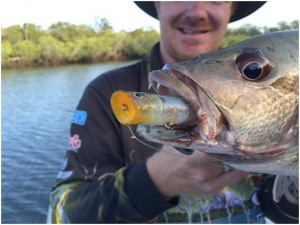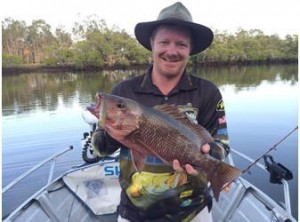Mangrove Jack Fishing Techniques by Robbie Rayner


So you want to catch a Mangrove Jack?
This is just some basic tips I have been taught, learnt and watch others do to become successful at landing that elusive Mangrove Jack.
I’m by far no expert but hopefully we can get you on the right track to land one of these Red Devils in your net!
I started lure fishing 5 years ago and like most I started out with a little bait and some lures, I would throw lures for 10 mins, then revert back to bait thinking to myself I must be doing it wrong? Well you can’t really use a lure wrong!
As most lure actions operate with just using the rod and some flicks or jerks of the wrist, or simply just wind the reel. So you can’t really get it wrong. You just need to be persistent and put that extra cast in.
I love chasing Mangrove Jack as they are a challenge on more levels than you can imagine. Firstly you have to seek a spot you think they might like. (the Hunt) get your lure right into that gnarly looking spot (the chase) entice your Jack friend to come out and attack your lure and basically hold on (the fight) landing them (the win)
When chasing Mangrove Jacks in estuary’s ect be prepared to lose some gear… and generally don’t skimp too much on the gear you buy, you don’t need to buy the dearest, but eBay $2 specials won’t cut it, and being an aggressive hard to land fish it would be shattering to lose that 50cm fish based on gear performance.
Mangrove Jack will attack their food/lure by coming out of their hidey hole, circle the lure and hit it on its way back to their hidey hole. So what does this mean for your beloved lure? It’s ( MJ ) on the front foot of getting back to its snag before you realise its hit your lure and quite possibly if you don’t turn his head quickly, goodbye lure hello “W0W” factor.

Rods & Reels
I personally use bait casters, and set up correctly are great to cast lures into tight snaggy areas as you have more control over the cast / landing, but this is not for everyone. A spin combo will suffice just perfectly.
My liking to a rods action is a nice fast action (stiffer tip) 3kg -5kg (6lb-10lb) I personally use the Tairyo range as I find them extremely affordable, high end quality with exceptional components. But don’t be too hung up on having the latest greatest rods most expensive rods, this is not necessary. The Matrix rod is exceptional value and will stand up to everything its intended for.
I have owned Mega Bass rods and caught the same amount of fish, high end is lovely to own but not a necessity to chase these guys.
Reels
I use an Alphas type R as I said I like bait casters, the Tatula and current Sol 2 are also great budgeted bait caster reels. My advice is if you’re looking to by a bait caster set up, don’t buy cheap. Anything under the $150 mark can be difficult to set up quickly with lure changes etc and “if difficult to use you will hate it and not use it.”
But your local tackle shops can advise your best options and also ask them how to set your bait caster up when swapping lures, as the settings will need to be adjusted with each different lure due to casting weight.
Spin reels, a 2500 series reel will be sufficient even something like the Shimano Sienna is a great reel for the price. I personally use a 2506 Sol 2 reel, as you don’t need 500m line capacity spool as Mangrove Jack do not take off for the ocean, they have short sharp hard bursts.
Line
As a general rule I use 20lb Sas braid or 15lb Gamma braid as I have confidence in these 2 brands. They are thin and strong for their breaking strains. I have been leaning towards to Gamma more of late.
Leader
I use generally Gamma or FC rock and depending on where I am at I will generally stick to 15lb and 20lb depending if I am fishing pylons which require a little more abrasion so I will use the 20lb. Running an FG knot, which there is a great YouTube clip on how to tie these: https://www.youtube.com/watch?v=yk7uWUa4z6Y

Lures
My choices are based on my confidence of the lure, and I am no way sponsored or affiliated with any of these brands.
Surface lures I like to use the Lucky Craft G Splash and the Sugapen 90, Halco Roosters and the new Ballista S-Pop with the LED technology.
Divers I have a preference to use Lucky Craft Pointers and 75mm Lucky Craft Bevy Shads suspending, Ballista Triggers but I also have some Atomic 75 Shiners also, these are a good cheaper lure to have in the kit.
Plastics, I have evolved a little, as I used to use the Zman Diesel MinnowZ and the SwimmerZ, but I didn’t like having to glue my plastic to the hook, and although there are aids now to help prevent the plastic from slipping off, I have currently been using the Berkley split belly’s and really like the side swaying action these give and best of all they are easy to rig up and don’t melt.

Weedless set up I use a worm hook 4/0 and tie a small sinker depending on how deep I want it to sink and how quickly I want it to sink this gives me flexibility to customise my sink rate.

If im fishing pylons I use a ½ ounce 4/0 Impact Tackle jig head, with the Matzu Sickle hook, when these bite in they don’t let go.

Techniques
If I am fishing surface, I will cast along a rock wall and work my popper along the wall, about 3-4 feet off the wall.
If I am fishing a pontoon, I will look for the eddy created by the current wrapping around the structure and work my lures on the edges of this, as if a fish has been caught in the current and too weak to get out. There’s not much to fishing surface, find structure cast at it and slight jerks of your rod to get the lure to splash or walk.
If I am fishing a pylon or bridge, or rock wall I tend to have my retrieve very quick, chasing the reaction strike (make the Jack feel it will miss out if it doesn’t decide to strike quickly. ) this is why I use a ½ ounce jig head here, sink fast and work it fast.
The hard bodies I will jerk till I hit a rock and stop for a second and then continue the jerk until back to the boat.
Suspending lures tend to sit there and not float or sink, so less chance of losing your lure to the crevice of a rock wall.
If I am looking for jacks in the mangroves, look for structure they will hide in, logs laying in the water, cut outs in the bank, exposed roots on the bank, sometimes if you have a favourite spot exploring low tide and seeing where some good spots are to hit up on high tides.

Something I learnt of a local video was to keep looking at the bank and if you see a heap of trees and then 1 missing and looks like the bank has collapsed or eroded, chances are there is a tree in the water now, where it once was on the bank.
I don’t have a preference on tides, run in run out, if caught them on both and I think it depends on the system and fish in it. But as the saying goes…..no run no fun so tide should be moving.
Well I hope this helps in anyway get you onto your first Mangrove Jack no matter the size, but I can promise you this, it is a species you will never forget the first catch.
As I fish a lot on my own, I don’t take lots of pictures as im just slack and I do it for my own love, but I have a couple and Brandon Hazelwood has also offered to share some also, as he is Also my Jack mentor.
Special Thanks….
Tackle Land would like to thank Robbie Rayner for taking the time to share his experience and knowledge with us all to help with the ultimate goal of bagging that worthy Red Dog – the Mangrove Jack!
I know my first experience tangling with a Mangrove Jack is not one I will forget in a hurry, the action was really fast and relentless, I thought I was fighting a beast but in reality it was a 38cm Jack!
Robbie has put together some great information on the basics so have a good read, put what you can into action and let us know how you go.
We would also like to hear about your experiences, tricks and tips so feel free to share in the “Comments” area below.
Thanks again Robbie for your hours of work.
Maintain the Passion

12 Comments
At last someone has imparted some knowledge to me. Thankyou very much.
Adam
Hi Adam, it is not a huge document but the idea is to have enough info to stop you getting frustrated (I still get that way chasing them!!!) I hope you got some useful info to work with. Happy Hunting!
Thanks mark for all your helpfull info. Regards Mark/Hoppy
All good Hoppy, it is the basics but as you know once you have that down pat, game is on!
I’m going out tomorrow to chase mangrove Jack’s with a friend and luckily me i bought all my rods over and not at home!! This helps out alot as i have heard all about them! I had to toss up between going fishing for jewies or mangrove Jack’s…not a hard pic as i have already got a few collections of jewies but 0 effort for mangrove Jack’s.. looking forward to tomorrow cheers.
Great information as it gives me good ideas on what to buy to use , I have been using beach worms fresh from the sand but no luck with the jacks yet
Jim
Good info. I’ll be back with river monster mangrove Jack. Yahhhh
this is helping with my school project
Dekin, I am so glad that this has been useful for you! Good luck with your school project, we would love to see a copy of it when you are finish if that is okay!
Hi Dekin, we are very happy that you can use some of this information in your school project! If you would not mind, we would like to see a copy of your finished project.
Great article! I’ve never even considered different sized rods for beginners, but it now makes sense that a smaller rod would be much easier to cast accurately. Thanks!
Hey Myles, sometimes we fish in really tight spaces and longer rods mean more “Tree Conflicts” and sometimes you just need to flick in front of you. Hope the info helped.